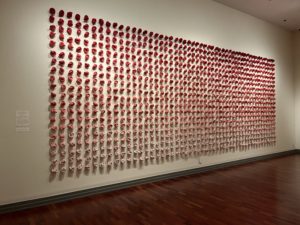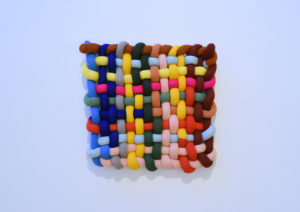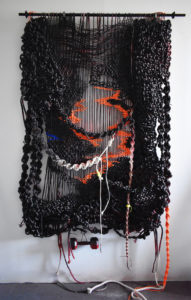
Meet the artists featured in the exhibition, A Beautiful Mess: Weavers and Knotters of the Vanguard, organized by the Bedford Gallery at the Lesher Center for the Arts in Walnut Creek, CA. This week we will highlight the final three artists on display. These artists push the boundaries of fiber art, infusing their works with personal stories and socio-political concerns to further revolutionize the previously marginalized artistic genre.
Lisa Solomon
Oakland, CA

Lisa Solomon, Senninbari {1000 stitch knot belt}, 2016, hand-dyed & tied cotton rope, 122 x 299 x 4 in. Courtesy of Walter Maciel Gallery, Los Angeles, CA.
Artist Statement
In many ways, my art is an experiment. My studio and the world I interact with is my laboratory. Like any good scientist, I pose questions and conduct research. My questioning is multi-linear. It is rooted in my attempts to understand myself, my personal history, as well as an interest in uncovering the profound in the immediacy of the everyday that surrounds us all.
As a half Japanese, half Jewish [Eastern European] Caucasian woman, hybridization is literally a part of my DNA and shows itself often in my practice. Influenced by my paternal grandmother [who was continually making things with her hands], I often choose to incorporate crochet, embroidery, felt, pins, etc. in my work. The history and connotations of these materials intrinsically add to the work. My work is in dialogue with contemporary art and the history of painting, but by using thread and craft materials I’m simultaneously in conversation with an aesthetic artistic sphere that is inherently more interior and domestic. It’s an interesting divide and space – the one within, outside, next to and near ART + CRAFT.
I am interested in the concept of distance – transitory or spatial, microscopic or global. I am concerned with my personal history and the distances [both literal and figurative] we travel to creative the fabric of our lives. How both people and things [radiation, cultural practices, information] travel the globe and intersect with one another.
I am interested in materiality. I often leave long threads hanging beyond the frame of the drawing they are a part of. I also connect hand made doilies to their thread balls – attempting perhaps to create an illusion of self-making. These threads are often a tribute to the process, but they also invoke ideas of memory, the passage of time, and even grief. I use thread to literally make connections, to signify relationships, to mark time and/or distance, to highlight desires and longings. Since they don’t lay the same way twice, they become an element of chance. They imply that there is always a possibility of transformation. They pull the drawings off the wall and force flatness into space. And they are ultimately something I CAN NOT control.
I am interested in repetition – the multiple – what happens when things are massed/swarmed beyond what might be comfortable. There is meditation in this, but also a complexity, a questioning of wholeness [can it ever be whole?]. Things en mass can become something other – both positive [as in a crowd all enjoying the same music at a concert] and negative [as in cells mutating and metastasizing into cancer].
I am interested in the act of labor itself; the domestic sphere and how in many ways it parallels the artistic sphere. Tied to this is an exploration of the differences between hand-made and machine-made objects: how culturally the desirability of each has swapped positions over time. How things made in a time-consuming manner connote ideas about work ethic.
Reflexively I often try to fix or make beautiful those things/events that most frighten me [viruses, environmental toxins, deforestation]. In my studio I can render harmless that which can cause pain or destruction and things that are out of my control.
I venture to bring attention and meaning to that which we might ignore. To point out that something we might deem insignificant or unnecessary can indeed harbor a story or offer a clue to who we are, how we live and how we interact with one another.
In the end what I make is fundamentally tied to the practice of drawing and the scientific method. I take a “by any means necessary” approach – incorporating concepts, materials and practices in any combination to satisfy the work. The work has seemingly found a home between 2D and 3D, usually shown on the wall and yet concurrently existing and yearning to be off of it. In this tenuous position my work, is in many senses of the phrase, “between states”.
Katrina Sánchez Standfield
Charlotte, NC

Katrina Sánchez Standfield, Waiting for Tomorrow, 2021, machine knitted yarn, fiberfill, 34 x 39 x 6 in.
Katrina Sánchez Standfield is an interdisciplinary Panamanian-American artist. Through fibers and mixed materials she makes vibrant and tactile objects and installations that examine the social and environmental networks in which we function. Kat pairs traditional processes like weaving and knitting, experimenting with texture, color, and scale to explore contemporary issues. The intersection in which we relate to ourselves, each other, and our environments is at the center of what inspires her work. She explores ideas of community, healing, and renewal through physical actions and methods like mending, street art, and interactive installations. Influenced by both the history of fibers and its intrinsic connection to humanity Kat likes creating work that invites the public to interact with it. A desire to elicit a multi-sensory experience while engaging the audience’s desire to investigate and play is at the heart of her practice.
Jacqueline Surdell
Chicago, IL

Jacqueline Surdell, Orange 2, 2018, braided cotton cord, steel curl bar, 15 lbs. weight, 104 x 59 x 15 in. Courtesy of Patricia Sweetow Gallery, San Francisco, CA.
Jacqueline Surdell was born and raised in Chicago, IL. Now the third largest city in the US (and the largest in the Midwest), Chicago’s history of industry, labor, and midwest grit plays a significant role in Surdell’s work. Surdell’s Polish Grandfather worked in the steel mills in Hegewisch, a neighborhood on the south side of Chicago, while her Dutch Grandmother is a landscape painter. The dichotomy established between manual labor and conceptual labor influenced Surdell at an early age. Listening to stories of the mills — the operation of massive blast furnaces, chaotic melting pits, and subsequent injuries, was complimented with memories of frolicking in wildflower fields while her grandmother painted the colorful landscape. The combination resulted in an early-developed arts view where life and work, body and labor, industry and craft, and the high-brow traditions of plein-air landscape painting, merged. Those close familial memories influence Surdell’s complex terrain between art-making, body, sanctuary and spirit.
From childhood through college Surdell was a competitive athlete. She approaches her studio practice with a disciplined resolve forged in the intense, repetitive, realm of competitive sports. Her years as an athlete primed her interest in repetitive, laborious, craft-based practices. Building her wall sculptures demands full body action, employing her body as a weaving shuttle, and her hand as brushstroke. Moving in and out of the warp, with pounds and yards of industrial rope on self-made mural sized looms. Although her material is fiber, her approach is painterly, manipulating her medium with knotted layers, reducing the material to open the structure, draping to create volume and texture.
Surdell approaches her studio practice with the meticulous precision of craft and the unbridled spontaneity of contemporary painting. She reimagines the woven canvas as a space of undulation and growth. As the expanded histories of painting materialize in her work as content, simultaneously, swollen tendrils and textures of bound rope deny illusions of the classically painted picture plane. The works actively work to bridge the division between painting and sculpture. In this way, her work calls into association other binary categorizations such as rigid and collapsed, construction techniques coded as masculine or feminine, and ontological spaces between body and sculpture. Her energetic and materially grounded practice brings to attention the tools, environments, and actions that contain and display performances of labor, history, and power.
Surdell lives and works in Chicago, IL. Recent solo and small group exhibitions include Patricia Sweetow Gallery, San Francisco, UW Parkside, Kenosha, Apparatus Projects, Chicago, Heaven Gallery, Chicago, and Chicago Artists’s Coalition, Chicago. Group exhibitions include Kunsthal KadE, Amersfoort, Netherlands, South Bend Museum of Art, South Bend, IN, Western Exhibitions, Chicago, and Antenna.Works, New Orleans.

